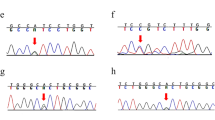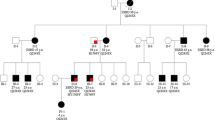Abstract
Polycystic kidney disease (PKD) is a systemic disorder which adds majority of renal patients to end stage renal disease. Autosomal dominant polycystic kidney disease (ADPKD) is more prevalent and leading cause of dialysis and kidney transplant. Linkage analysis revealed some closely linked loci, two of which are identified as PKD1, PKD2 and an unidentified locus to ADPKD. This study was performed using PCR and automated DNA sequencing in 84 cases and 80 controls to test potential candidature of PKD2 as underlying cause of PKD by in silico and statistical analyses. Two associated symptoms, hypertension (19%) and liver cyst (31%) have major contribution to PKD. Gender-based analysis revealed that familial female patients (27%) and familial male patients (33%) are more hypertensive. Liver cyst, the second major contributing symptom presented by large percentage of sporadic males (46%). Genetic screening of all 15 exons of PKD2 revealed eight pathogenic (c.854_854delG, c.915C>A, c.973C>T, c.1050_1050delC, c.1604_1604delT, c.1790T>C, c.2182_2183delAG, c.2224C>T) and eight likely pathogenic (g.11732A>G, c.646T>C, c.1354A>G, g.39212G>C, c.1789C>A, c.1849C>A, c.2164G>T, c.2494A>G) DNA sequence variants. In our study, 27.38% (23/84) cases shown pathogenic / likely pathogenic variants in PKD2 gene. Some regions of PKD2 prone for genetic variation suggested to be linked with disease pathogenesis. This noticeable hot spot regions hold higher frequency (50%) of pathogenic / likely pathogenic genetic variants constituting single nucleotide variants than large deletion and insertion that actually represents only 41.08% of coding sequence of PKD2. Statistically significant association for IVS3-22AA genotype was observed with PKD, while association of IVS4+62C>T was found insignificant.


Similar content being viewed by others
References
Carrera P., Calzavara S., Magistroni R., den Dunnen J. T., Rigo F., Stenirri S. et al. 2016 Deciphering variability of PKD1 and PKD2 in an Italian cohort of 643 patients with autosomal dominant polycystic kidney disease. Sci. Rep. 6, 1–13.
Daoust M. C., Reynolds D. M., Bichet D. G. and Somlo S. 1995 Evidence for a third genetic locus for autosomal dominant polycystic kidney disease. Genomics 25, 733–736.
De Bruyn R. and Gordon I. 2000 Imaging in cystic renal disease. Arch. Dis. Child. 83, 401–407.
Fick G. M. and Gabow P. A. 1994 Hereditary and acquired cystic disease of the kidney. Kidney Int. 46, 951–964.
Gardner K. D. 1988 Cystic kidneys. Kidney Int. 33, 610–621.
Grantham J. J. 2002 Polycystic kidney disease: old disease in a new context. Trans. Am. Clin. Climatol. Assoc. 113, 211–224.
Hayashi T., Mochizuki T., Reynolds D. M., Wu G., Cai Y. and Somlo S. 1997 Characterization of the exon structure of the polycystic kidney disease 2 gene (PKD2). Genomics 44, 131–136.
Jeffery S., Morgan S., Warmington V. J., MacGregor G. A. and Saggar-Malik A. K. 1995 A family with autosomal dominant polycystic kidney disease linked to 4q21-23. J. Med. Genet. 32, 493–494.
Liu W. Q., Chen M., Wei J., He W., Li Z., Sun X. et al. 2014 Modification of PCR conditions and design of exon specific primers for the efficient molecular diagnosis of PKD1 mutations. Kidney Blood Press Res. 39, 536–545.
Mochizuki T., Wu G., Hayashi T., Xenophontos S. L., Veldhuisen B., Saris J. J. et al. 1996 PKD2, a gene for polycystic kidney disease that encodes an integral membrane protein. Science 272, 1339–1342.
Neumann H. P., Bacher J., Nabulsi Z., Ortiz Brüchle N., Hoffmann M. M., Schaeffner E. et al. 2012 Adult patients with sporadic polycystic kidney disease: the importance of screening for mutations in the PKD1 and PKD2 genes. Int. Urol. Nephrol. 44, 1753–1762.
Obeidova l., Elisakova V., Strekrova J., Reiterova J., Merta M., Tesar V. et al. 2014 Novel mutations of PKD gene in Czech population with autosomal dominant polycystic kidney disease. BMC Med. Genet. 15, 41–52.
Pei Y. 2006 Diagnostic approach in autosomal dominant polycystic kidney disease. Clin. J. Am. Soc. Nephrol. 1, 1108–1114.
Reeders S. T., Breuning M. H., Corney G., Jeremiah S. J., Meera Khan P., Davies K. E. et al. 1986 Two genetic markers closely linked to adult polycystic kidney disease on chromosome 16. Br. Med. J. 292, 851–853.
Stekrova J., Reitorava J., Merta M., Damborsky J., Zidovská J., Kebrdlová V. et al. 2003 PKD2 mutations in a Czech population with autosomal dominant polycystic kidney disease. Nephrol. Dial. Transplant 19, 1–7.
Torres V. E., Harris P. C. and Pirson Y. 2007 Autosomal dominant polycystic kidney disease. Lancet 369, 1287–301.
Tsiokas L., Kim E., Arnould T., Sukhatme V. P. and Walz G. 1997 Homo- and heterodimeric interactions between the gene products of PKD1 and PKD2. Proc. Natl. Acad. Sci. 94, 6965–6970.
Yoder B. K., Hou X. and Guay-Woodford L. M. 2002 The polycystic kidney disease proteins, polycystin-1, polycystin-2, polaris, and cystin, are co-localized in renal cilia. J. Am. Soc. Nephrol. 13, 2508–2516.
Zerres K., Völpel M. C. and Wei B. H. 1984 Cystic kidneys: genetics, pathologic anatomy, clinical picture, and prenatal diagnosis. Hum. Genet. 68, 104–135.
Acknowledgements
We are very thankful to the patients and healthy control individuals for their participation. SR is thankful to UGC, New Delhi, India for providing SRF. This work was supported by UGC-UPE focus area-II, Banaras Hindu University, India.
Author information
Authors and Affiliations
Corresponding author
Additional information
This study was designed by PD (Parimal Das) and the experiments were performed by SR (Sonam Raj). Clinical diagnosis was carried out by RGS (Rana Gopal Singh) and senior residents (Drs Kishan, Shiv Shankar and Pragya). Manuscript was drafted by SR and PD.
Corresponding editor: Arun Kumar
Rights and permissions
About this article
Cite this article
Raj, S., Singh, R.G. & Das, P. Mutational screening of PKD2 gene in the north Indian polycystic kidney disease patients revealed 28 genetic variations. J Genet 96, 885–893 (2017). https://doi.org/10.1007/s12041-017-0824-5
Received:
Revised:
Accepted:
Published:
Issue Date:
DOI: https://doi.org/10.1007/s12041-017-0824-5




